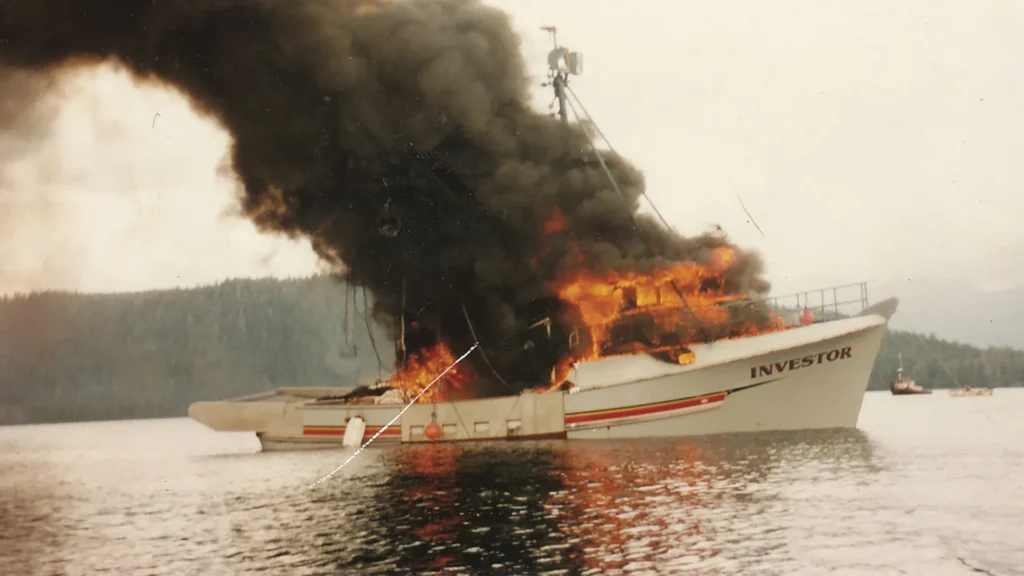April 7, 1990: The Scandinavian Star Ferry Fire – A Tragedy That Still Demands Answers
In the early hours of April 7, 1990, a catastrophic fire engulfed the passenger ferry Scandinavian Star, claiming the lives of 159 people. The blaze, later determined to be the result of arson, remains one of the most haunting maritime disasters in modern European history. More than three decades later, the events aboard that ill-fated vessel continue to cast a long, dark shadow — not only for the families of the victims but for an entire region that demands accountability, transparency, and justice An arson attack on the passenger ferry.
A Routine Voyage Turned Deadly
The Scandinavian Star was a 10,819-ton passenger ferry built in France in 1971. Originally known as the Massalia, she had changed hands and names several times before her final voyage. By 1990, the ferry had been purchased by the Danish company DA-NO Linjen to service the route between Oslo, Norway, and Frederikshavn, Denmark.
On the night of April 6, 1990, the ferry departed Oslo with 395 passengers and 97 crew members. The majority of the passengers were Norwegian citizens, many traveling with families on holiday. On the surface, it was supposed to be a routine overnight journey across the Skagerrak Strait An arson attack on the passenger ferry.
But by the early morning of April 7, what began as an uneventful voyage turned into a scene of unimaginable horror. At around 2:00 AM, a fire broke out on Deck 3. Within minutes, smoke and flames spread rapidly throughout the ship. Chaos ensued as passengers and crew scrambled to escape the inferno.
A Blaze Fueled by Flammable Materials and Poor Design
One of the major factors that contributed to the deadly toll was the ship’s interior. The Scandinavian Star had recently been refurbished, and investigators later discovered that many of the materials used in the refurbishments were highly flammable. Carpet, wall coverings, and ceiling panels emitted toxic fumes when burned, quickly filling corridors and cabins with deadly smoke.
Compounding the danger was the ship’s layout and safety infrastructure. The fire alarm system failed to adequately warn passengers. Emergency exits were poorly marked, and escape routes were often narrow and hard to navigate. The ferry also lacked sufficient fire doors to contain the blaze, and many of the crew were unfamiliar with the ship and its emergency procedures — some could not even speak the same language as the passengers.
Many victims were trapped in their cabins, overcome by smoke inhalation before they could even reach the corridors. The blaze raged for hours before being brought under control, but by then, 159 lives had been lost — including many women and children An arson attack on the passenger ferry.
Initial Investigations and Charges
Authorities quickly determined that the fire had been started intentionally. A Danish truck driver who died in the fire was initially suspected of being the arsonist. The theory was that he had a history of mental illness and had previously attempted suicide. However, this claim was never conclusively proven, and many, including victims’ families and independent investigators, believed the case was prematurely closed.
The ship’s crew and ownership also came under heavy scrutiny. Critics pointed to serious lapses in safety protocols and training. Many of the crew had only been hired days before the voyage and were unfamiliar with emergency routines. In some cases, crew members reportedly abandoned ship without assisting passengers — a breach of maritime duty that enraged survivors and families alike.
Despite public outcry, no one was ever convicted of intentionally starting the fire. The only legal consequences fell on the ship’s management for safety violations. The Scandinavian Star disaster thus joined the tragic ranks of maritime incidents where justice appeared elusive An arson attack on the passenger ferry.
A Complicated Web of Ownership
One of the reasons this case has remained so controversial for over 30 years is the convoluted and opaque ownership structure of the vessel. While the ship sailed under a Bahamian flag — a common practice known as “flag of convenience” used to circumvent stricter regulations — its ownership was traced to a labyrinth of shell companies.
At the time of the disaster, DA-NO Linjen had only recently purchased the vessel from SeaEscape Ltd., a company based in Miami, Florida. But after the tragedy, the paper trail revealed a network of leases, subleases, and management agreements that made it difficult to identify who was truly responsible for the ship’s condition and staffing.
This tangled corporate web led to widespread suspicion. Could financial motives, such as insurance fraud, have played a role in the tragedy? Was the fire set intentionally to sink the ship and collect insurance money? These questions fueled numerous unofficial investigations and media exposés, but few concrete answers emerged.
Survivors Speak Out
Over the years, survivors and victims’ families have become some of the most vocal critics of how the disaster was handled. Many have fought tirelessly for transparency and justice, arguing that the official explanation — a lone arsonist who perished in the fire — was not only unsubstantiated but a convenient way to close a complex and politically sensitive case.
Survivors recounted scenes of terror and confusion aboard the burning ship: pitch-black hallways filled with thick, acrid smoke; children screaming for help; desperate passengers smashing windows to escape. Some jumped into the frigid sea, clinging to lifeboats or floating debris until rescued. Others recounted being ignored or misled by panicked crew members who had little to no training in emergency response.
In interviews and testimonies over the decades, these survivors have described a deep, lingering trauma — not just from the night itself, but from the years of silence and obfuscation that followed.
Renewed Investigations and Conspiracy Allegations
In 2013, a Danish parliamentary commission reopened the case, citing new forensic evidence and witness statements that challenged the original investigation’s conclusions. Experts pointed to multiple ignition points, suggesting the fire had not been started by a single individual acting alone. The possibility of coordinated arson — potentially linked to financial motives — re-entered the public discourse.
A 2020 Norwegian police report acknowledged serious flaws in the initial investigation. It confirmed that the likely arsonist was not the Danish truck driver, and that the fire may have been part of a larger conspiracy. Yet, even with this admission, no new charges were filed.
This lack of accountability continues to frustrate those affected by the disaster. Activists and families argue that the investigation’s failures — including the immediate destruction of evidence and the premature conclusion about the arsonist’s identity — constitute a cover-up.
Legacy and Lessons
The Scandinavian Star disaster led to some changes in maritime safety regulations, particularly regarding the use of flammable materials and crew training requirements. But for many, these changes were too little, too late.
In Denmark and Norway, the disaster is etched into national memory. Annual memorials are held to honor the victims. Public monuments bear the names of the deceased. Documentaries, books, and podcasts continue to explore the tragedy, ensuring that it is neither forgotten nor swept under the rug.
The ferry itself was eventually scrapped, but its legacy endures as a cautionary tale about greed, regulatory failure, and the human cost of negligence. It’s a painful reminder that safety must never be compromised — and that justice delayed is often justice denied.
A Call for Closure
As of 2025, 35 years have passed since the fire. The victims’ families continue to call for an independent international inquiry — one with full subpoena power and access to all evidence, regardless of corporate or national jurisdiction. They want not just answers, but accountability: for the arsonist, for the owners, and for the officials who failed to protect innocent lives.
In an age when digital records and forensic science offer unprecedented tools for investigation, many hope that modern techniques might finally unlock the truth. The Scandinavian Star is more than a ship; it is a symbol — of pain, of injustice, and of the need for persistent vigilance in the face of bureaucratic silence.
Final Thoughts
The tragedy of the Scandinavian Star is not just a historical footnote — it’s a living wound for hundreds of families, a legal mystery that remains unsolved, and a maritime disaster that continues to reverberate across generations. Its lessons are chillingly relevant today: the importance of transparency, the dangers of deregulation, and the human consequences when profit is prioritized over people.
History has not yet rendered its final verdict on what happened that night. Until it does, the haunting image of a burning ferry in the middle of the sea — and the 159 lives lost within it — demands our remembrance, our outrage, and our action.



















